|
This will be the last issue of Horticulture 2017. The first issue of Horticulture 2018 will be sent on January 9.
Your current subscription for the newsletter will continue as is, so nothing will be necessary on your part to continue receiving it. Please tell anyone you know who might be interested in subscribing that they are encouraged and welcome to do so by sending an e-mail to Ward Upham at wupham@ksu.edu requesting a subscription. On behalf of all of us at K-State we wish you a Merry Christmas and Happy New Year. (Ward Upham) 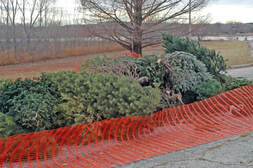 After the holidays, many municipalities allow old Christmas trees to be placed curbside. Trees are then collected and ground up for mulch or burned. If you miss the designated date, or your trash collector doesn't accept trees, there are several options to prolong the useful life of the tree. An old Christmas tree can be used to benefit birds, fish, and the landscape by placing it in a corner of your deck, and spreading some birdseed nearby, or tying it to a deciduous tree or post near a bird feeder. The birds benefit from having escape cover nearby when hawks or cats threaten, and the dense boughs reduce the wind chill on a cold night. Sinking your Christmas tree in a pond is an easy way to improve fish habitat and fishing. The tree serves as little coral reef, in that the branches provide substrate for water plants to grow, and cover for minnows and other forms of small aquatic life. Larger fish are drawn by the shade and the presence of prey. How do you sink a tree? Tie the base to a cinder block with a short, stout rope, and toss it in. Just be sure to get permission from the pond owner first! Using the little tree around the landscape requires clipping off all of the branches. Use the boughs to add extra insulation around semi-hardy perennials or to trees and shrubs that were recently planted. The leftover trunk may be used as a garden stake next spring. Or cut and let it dry for a few weeks, and you will have some easy lighting firewood. Just beware that most conifer species tend to spark and pop more than hardwoods, as resin pockets in the wood make tiny explosions. This can delight the youngsters, but for safety's sake, keep an eye on the fire when burning Christmas tree logs! (Charlie Barden) 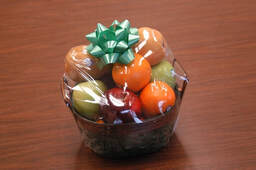 A holiday tradition is to give gifts of fruits and nuts (along with other products). Usually these are placed in an attractive basket, wrapped with cellophane covering, and brought (or shipped) to your house. It is important that the fruit contained inside is kept in cool conditions to maintain its quality for as long as possible. Thus, it is wise to disassemble the fruit basket as soon as you receive it and place the fruit in refrigerated storage. If all the products in the basket are tree fruits (such as apples, pears, oranges or grapefruit), you can place the entire basket in a cool place- around 40 degrees F for best results. If the basket contains any bananas or other tropical fruits (with the exception of citrus), remove those fruits and store them separately. About 3-4 weeks is about as long as you can expect to store these fruits without some shriveling and loss of crispness. (Ward Upham) 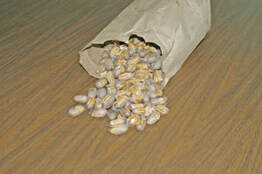 During the holiday season, pecans and other nuts are commonly given as gifts or purchased for holiday cooking. Nuts can quickly lose quality if not stored properly. Excessive water loss can lead to shriveled nutmeats, and the fats and oils in nuts can quickly spoil – developing an off-flavor or rancid taste. Store shelled (or unshelled nuts) in the refrigerator, or preferably the freezer. Nuts quickly absorb flavors from other stored products, so store them in a tightly sealed container so they won’t lose water or absorb flavors from other fruits or vegetables. A solid plastic container with a tightly fitting lid is preferred. You can use a heavy grade resealable plastic bag as well. If nutmeats are tightly sealed, they can be stored in a freezer for up to one year, but using them within six months is preferred. (Ward Upham) 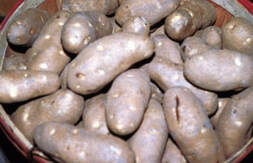 Potatoes stored below 40 degrees F will not sprout and will remain firm for long periods. However, such storage will often lead to starches being converted to sugars, which will give tubers an undesirable sweet taste. Placing potatoes at room temperature for 2 to 3 days will allow sugars to be converted back to starches and remove the objectionable taste. (Ward Upham) 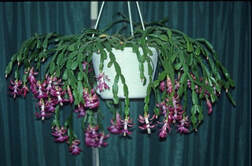 Christmas Cactus (Schlumbergera bridgesii) and Thanksgiving Cactus (Schlumbergera truncata) are epiphytes native to the jungles of South America. Epiphytic plants grow on other plants and use them for support but not for nutrients. Though these cacti are different species, they will hybridize and produce varying stem shapes. Christmas cactus normally has smooth stem segments, and Thanksgiving Cactus has hook-like appendages on each segment. Both of these cacti prefer bright indirect light. Too much sun can result in the leaves turning yellow. Common household temperatures are fine. Soil should be kept constantly moist but not waterlogged. Give them a light fertilization every other week. Blooming will normally cease in late winter to early spring, but continue to keep them moist and fertilized until fall. During the fall, stop fertilizing, and give the plants only enough water so the stems do not shrivel in order to encourage flower bud formation. Though these plants seem to flower best if kept a little pot bound, flowers will diminish if they are too crowded. If you haven't repotted in several years, or if you notice a decrease in flowering from the previous year, move the plant to a larger pot in the spring. If possible, move the plants outside for the summer. Choose a shady spot because these plants will not tolerate full sun. Leave the plants outside until frost threatens. Normally, the plants will have received enough cool nights in the 50- to 55-degree range that flower buds will have formed. However, if they haven't, subjecting the plants to nights greater than 12 hours long and temperatures between 59 and 69 degrees can also generate flowers. Twenty-five consecutive long nights is enough for flower initiation. Place the plants in an unused room or cover them with a dark cloth or cardboard box to insure that they receive uninterrupted darkness. After the flower buds have formed, it takes an additional nine to 10 weeks for flowers to complete development and bloom. (Ward Upham) 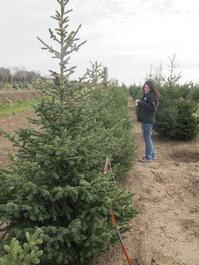 If selecting a cut tree, watch for these signs that the tree is too far gone. - Needles are a dull, grayish-green color - Needles fail to ooze pitch when broken apart and squeezed - Needles feel stiff and brittle - Needles pull easily off tree Once you have your tree home, recut the trunk about one inch above the original cut. This will open up clogged, water-conducting tissues. Immediately place the trunk in warm water. Locate the tree in as cool a spot as possible. Avoid areas near fireplaces, wood-burning stoves and heat ducts as the heat will result in excess water loss. Make sure the reservoir stays filled. If the reservoir loses enough water that the bottom of the trunk is exposed, the trunk will need to be recut. Adding aspirins, copper pennies, soda pop, sugar and bleach to the water reservoir have not been shown to prolong the life of a tree. If you choose a living Christmas tree, be sure to dig the planting hole before the ground freezes. Mulch the hole and backfill soil to keep them from freezing. Live trees should not be kept inside for more than three days. Longer periods may cause them to lose dormancy resulting in severe injury when planted outside. You may wish to tag the tree at the nursery and then pick it up a couple days before Christmas. After Christmas, move the tree to an unheated garage for several days to acclimatize it to outside temperatures. After planting, water well and leave some mulch in place to prevent the soil water from freezing and becoming unavailable for plant uptake. (Ward Upham) 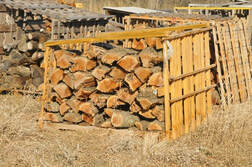 Not all firewood is created equal. Some species of trees are able to produce much more heat per cord of wood. A cord is the amount of wood in a well-stacked woodpile measuring 4 feet wide by 8 feet long by 4 feet high. Below are heat values (in million BTUs) per cord for various species of trees. The higher the value, the better the wood. The Kansas Forest Service has a publication titled “Managing Your Woodland for Firewood” that is quite helpful. See http://www.ksre.ksu.edu/bookstore/pubs/mf773.pdf . Remember to obtain firewood locally. Emerald Ash Borer is now in Kansas because of transported wood. (Ward Upham)
|
AuthorsCynthia Domenghini runs the Horticulture Response Center in the Department of Horticulture and Natural Resources at Kansas State University. Other contributors include K-State Extension Specialists. Archives
March 2024
Categories
All
|
| K-State Research and Extension Horticulture Newsletter |
|
 RSS Feed
RSS Feed
